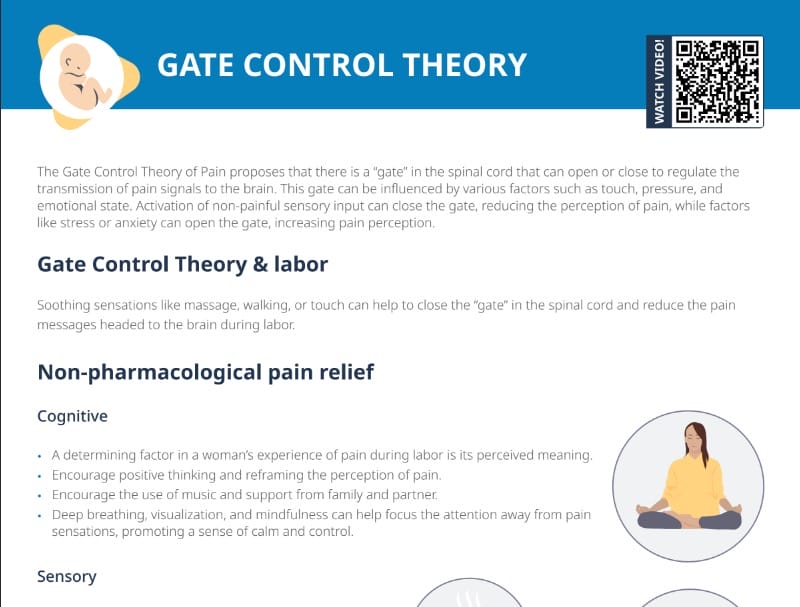What is the Gate Control Theory of Pain? Definition
The Gate Control Theory of Pain proposes that there is a “gate” in the spinal cord that can open or close to regulate the transmission of pain signals to the brain. This gate can be influenced by various factors such as touch, pressure, and emotional state. Activation of non-painful sensory input can close the gate, reducing the perception of pain, while factors like stress or anxiety can open the gate, increasing pain perception.
Gate Control Theory applied to pain relief during labor
Nonpharmacological pain relief methods are generally considered safe and effective, without the risks associated with pharmacological interventions.
Cognitive, sensory, and cutaneous methods can help to close the “gate” in the spinal cord and reduce the pain messages headed to the brain during labor.
Related videos
Cognitive pain relief methods in labor
Directing attention
- Encourage positive thinking and reframing the perception of pain.
- Encourage the use of music and support from family and partner.
- Deep breathing, visualization, and mindfulness can help focus the attention away from pain sensations, promoting a sense of calm and control.
How does a woman who feels in control of the situation during labor influence her pain?
A determining factor in a woman’s experience of pain during labor is its perceived meaning.
Perceiving pain as meaningless or unnecessary can heighten anxiety and intensify pain sensations. Clients who perceive their pain as productive and purposeful tend to have a more positive emotional response to pain, leading to them being able to better manage and tolerate it. You can support your client by helping them see labor pain as a meaningful part of the process.
Sensory pain relief methods in labor
Massages
Gentle massage or counter-pressure applied to areas experiencing discomfort can stimulate sensory nerves, activating the “gate” in the spinal cord to close and inhibit pain transmission.
Scents/aromas
Scents, such as lavender or chamomile, can have calming effects, reducing stress and anxiety and diminishing the perception of pain.
Baths
Immersing in warm water can alleviate muscle tension and promote relaxation.
Cutaneous pain relief methods in labor
TENS
TENS (Transcutaneous Electrical Nerve Stimulation) uses low-voltage electrical currents applied to the skin via electrodes to interfere with pain signal transmission and promote the release of endorphins.
Acupressure and acupuncture
Stimulating specific points on the body through pressure or fine needles can trigger the release of endorphins and reduce perception of pain.

